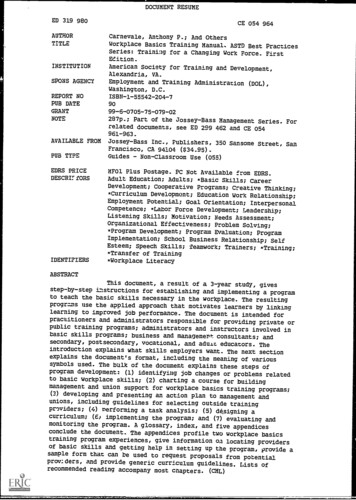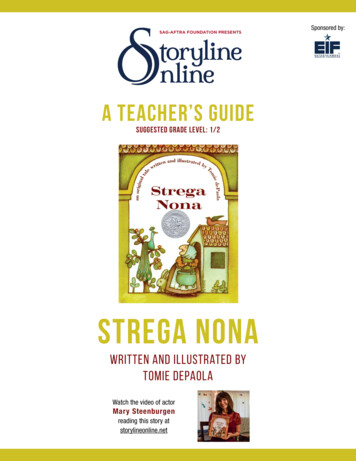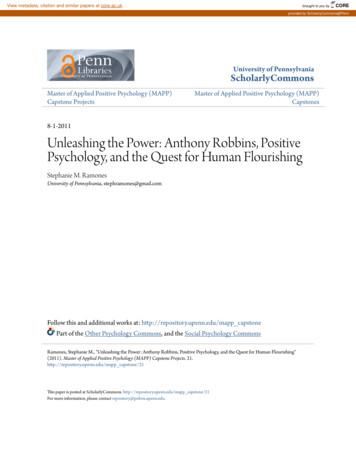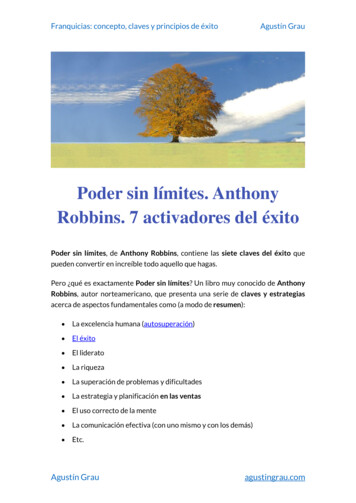
Transcription
DOCUMENT RESUMEED 319 980AUTHORTITLEINSTITUTIONSPONS AGENCYREPORT NOPUB DATEGRANTNOTEAVAILABLE FROMPUB TYPEEDRS PRICEDESCRIrfORSIDENTIFIERSCE 054 964Carnevale, Anthony P.; And OthersWorkplace Basics Training Manual. ASTD Best PracticesSeries: Training for a Changing Work Force. FirstEdition.American Society for Training and Development,Alexandria, VA.Employment and Training Administration (DOL),Washington, D.C.ISBN-1-55542-204-79099-5-0705-75-079-02287p.; Part of the Jossey-Bass Management Series. Forrelated documents, see ED 299 462 and CE 054961-963.Jossev-Bass Inc., Publishers, 350 Sansome Street, SanFrancisco, CA 94104 ( 34.95).Guides - Non-Classroom Use (055)MFO1 Plus Postage. PC Not Available from EDRS.Adult Education; Adults; *Basic Skills; CareerDevelopment; Cooperative Programs; Creative Thinking;*Curriculum Development; Education Work Relationship;Employment Potential; Goal Orientation; InterpersonalCompetence; *Labor Force Development; Leadership;Listening Skills; Motivation; Needs Assessment;Organizational Effectiveness; Problem Solving;*Program Development; Program Evaluation; ProgramImplementation; School Business Relationship; SelfEsteem; Speech Skills; Teamwork; Trainers; *Training;*Transfer of Training*Workplace LiteracyABSTRACTThis document, a result of a 3-year study, givesstep-by-step instructions for establishing and implementing a programto teach the basic skills necessary in the workplace. The resultingprograms use the applied approach that motivates learners by linkinglearning to improved job performance. The document is intended forpractitioners and administrators responsible for providing private orpublic training programs; administrators and instructors involved inbasic skills programs; business and management consultants; andsecondary, postsecondary, vocational, and adult educators. Theintroduction explains what skills employers want. The next sectionexplains the document's format, including the meaning of varioussymbols used. The bulk of the document explains these steps ofprogram development: (1) identifying job changes or problems relatedto basic workplace skills; (2) charting a course for buildingmanagement and union support for workplace basics training programs;(3) developing and presenting an action plan to management andunions, including guidelines for selecting outside trainingproviders; (4) Performing a task analysis; (5) dksigning acurriculum; (6) implementing the program; and (7) evaluating andmonitoring the program. A glossary, index, and five appendicesconclude the document. The appendices profile two workplace basicstraining program experiences, give information oa locating providersof basic skills and getting help in setting up the program, provide asample form that can be used to request proposals from potentialprov:ders, and provide generic curriculumguidelines. Lists ofrecommended reading accompany most chapters. (CML)
Anthony P. CarnevaleBEST COPYAv4ABLEILLeila I GainerAnn S. MeltzerWORa. .ACT.:BEAL/.iRtik 111 I 73JALU.S. DEPARTMENT OF EDUCATIONOfED"PERMISSION TO REPRODUCE THISof Educational Research and ImprovementDONAL RESOURCES INFORMATIONCENTER (ERIC)MATERIAL IN MICROFICHE ONLYHAS BEEN GRANTED BYThis document has been reproduced asa4usooiwetireceived from the person or organizationoriginating it0 Minor changes have bean made to improvereproduction duality40,0,, Pai?,icgvt- 'Z.,'Points of view or oPnions stated in this docwmerit do not necessarily represent officialOERI position or policy2TO THE 'EDUCATIONAL RESOURCESINFORMATION CENTER (ERIC)."ASTD Best Practices Series: Training for a Changing Work Force
Anthony P CarnevaleLeila I GainerAnn S. MeltzerWORKPLACEBASICS'MAL ,INGMANUAL111116.A Publication of theAmerican Society for Training and Developmentu: Jossey-Bass PublishersMr San FranciscoOxford1990
WORKPLACE BASICS TRAINING MANUALby Anthony P. Carnevale, Leila J. Gainer, and Ann S. MeltzerCopyright 1990 by Jossey-Bass Inc., Publishers350 Sansome StreetSan Francisco, California 94104Jossey-Bass LimitedHeadington Hill HallOxford OX3 OBWAmerican Society for Training and Development1630 Duke Street Box 1443Alexandria, Virginia 22.3)3Copyright under International, Pan American, and Universal CopyrightConventions. All rights reserved. No part of this book may be reproducedin any formexcept for brief quotation (not to exceed 1,000 words) ina review or professional workwithout permission in writing from thepublishers.Library of Congress Cataloging-in-Publication DataCarnevale, Anthony PatrickWorkplace basics training manual / Anthony P. Carnevale, Leila J. Gainer,Ann S. Meltzer.1st ed.p. cm.(The Jossey-Bass management series)Includes bibliographical references.ISBN 1-55542-204-71. EmployeesTraining ofUnited StatesHandbooks, manuals, etc.2. Employer supported educationUnited States.L Gainer, Leila J.II. Meltzer, Ann S. III. Title. IV. Series.HF5549.5.T7C2985 1990 suppL6583'124de2089-48805CIPManufactured in the United States of AmericaThe paper in this book meets the guidelines forpermanence and durability of the Committee onProduction Guidelines for Book Longevity of theCouncil on Library Resources.The case study from Mazda presented in Resource A is included hereinwith permission of the Mazda Motor Manufacturing (USA) Corporation.The case study from Harrison Radiator presented in Resource Bis induded herein with permission of Harrison Radiator Division,General Motors Corporation.JACKET DESIGN 1W WILL' I BAUMFIRST EDITIONCode 90124
The Jossey-Bass Management SeriesASTD Best Practice Series:Training for a Changing Work Force
The material in this project was prepared under Grant No. 99-6-0705-75-079-02from the Employment and Training Administration, U.S. Department of Labor,under the authority of Title IV, part D, of the Job Training Partnership Act of 1982.Grantees undertaking such projects under government sl insorship are encouragedto express freely their professional judgment. Therefore, points of view or opinionsstated in this document do not necessarily represent the official position or policyof the Department of Labor.6
ixContentsxvPrefacexixAcknowledgmentsxxiThe AuthorsxxiiiWorkplace Basics Advisory PanelxxvWorkplace Basics Skills Network1Introduction: Building a Training Program Around Essential Skills3The Skills Employers Want5Taking the First Step5Blueprint for Success: How to Create a Workplace BasicsTraining Program9101.1Blueprint for SuccessHow to Use the ManualStep One: Identify Job Changes or Problems Related toBasic Workplace ing ObjectivesIntroductionThe Investigator: Assess the Extent of the ProblemFormalize the Representative Advisory CommitteeWin Employee Acceptance and SupportPerform a Job AnalysisDocument Employee Performance ProblemsIdentify Populations to Be Targeted for TrainingBuild Cooperation with the UnionsExplore Possible Training OptionsReferences and Suggested Readings7
xContents2.1Step Two: Build Support for Training Through Alliances withManagement and Unions2.12.32.32.82.133.13.33.33.123.19Learning ObjectivesIntroductionPresent the Strategy and Action Plan for TrainingSelect Training Program ArchitectsReferences and Suggested ReadingsStep Four: Perform a Task e Program Advocate: Making the Case for Skills TrainingThe Program Advocate: Building Support for Skills TrainingReferences and Suggested ReadingsStep Three: Present the Strategy and Action Plan for Approval3.14.1Learning ObjectivesIntroductionLearning ObjectivesIntroductionDefine the Task AnalysisCollect Information Needed to Design the ProgramIdentify Sources of InformationPlan the Task AnalysisPerform the Task AnalysisCollect InformationSelect a Quick Route Through Task AnalysisThe Task Analysis: How to Approach It GenericallyReferences and Suggested ReadingsStep Five: Design the ng ObjectivesIntroductionWhat Is Performance-Based Training?What Is Functional Context Learning?Design Performance ObjectivesDesign Criterion-Referenced TestsDesign Evaluation InstrumentsDesign and Develop a Documentation andRecord-Keeping SystemObtain Final Budget Approval to ImplementReferences and Suggested Readings
xiContents6.1Step Six: Develop the Program6.20Learning ObjectivesIntroductionPrepare the Course OutlineDevelop Lesson PlansDevelop Instructional MaterialsEvaluate Training MaterialsUse Concepts of Adult LearningConsider Learning StylesSelect Audio-Visual MaterialsIntegrate Instructional TechniquesClassroom TrainingChoose an Effective Training Methodology6.24When to Use Which Method6.266.26Select Facilities and EquipmentFacilities Design for Individualized InstructionDevelop Evaluation and Monitoring InstrumentsReferences and Suggested .297.1Step Seven: Implement the 8.1Learning ObjectivesIntroductionSelecting the Program ManagerSelecting the Program AdministratorSelecting the Instructional StaffTrain-the-Trainer WorkshopPeer TrainersUsing the Buddy SystemCounselorsDevelop a Learning Contract-Yes or No?Should the Program Be Pilot Tested?References and Suggested ReadingsStep Eight: Evaluate and Monitor the Program8.18.38.68.68.78.148.158.198.20Learning ObjectivesIntroductionReasons to EvaluatePurposes and Uses of EvaluationTypes of EvaluationFeasibility of the Evaluation SystemProvide Program MonitoringConnect Back to ManagementReferences and Suggested Readings9
xiiContentsA.1Resource A: A New Plant Perspective: Case Study from Mazda(The Applied Approach)Mazda: A Program for a New PlantB.1Resource B: An Established Plant View: Case Study fromHarrison Radiator (The Applied Approach)C.1Resource C: The Providers: Where to Get Help forWorkplace Basics Community and Junior CollegesPrivate Industry CouncilsFour-Year Colleges and UniversitiesVolunteer Literacy OrganizationsThe U.S. MilitaryCommunity-Based OrganizationsEmployer-Funded ConsortiaUnion TrainingTrade and Professional AssociationsConsultants and Vendors of TrainingResource D: Sample Requests for ProposalsD.1D.2E1Local School DistrictsBackgroundRequired Format for Submitting ProposalsResource E: Generic Curriculum Guidelines for PromotingWorkplace .15E17E20E.22E24Approaches to Learning-to-LearnContent Guidelines for Learning-to-Learn Skills TrainingReading, Writing, and ComputationContent Guidelines for Reading Skills TrainingContent Guidelines for Writing Skills TrainingContent Guidelines for Computation TrainingContent Guidelines for Oral Communication TrainingContent Guidelines for Listening Skills TrainingContent Guidelines for Problem-Solving Skills TrainingContent Guidelines for Creative Thinking Skills TrainingContent Guidelines for Self-Esteem Skills TrainingContent Guidelines for Motivation and Goal-Setting SkillsTrainingContent Guidelines for Employability Skills TrainingContent Guidelines for Career Development Skills TrainingContent Guidelines for Interpersonal Skills Training10
ContentsE.25G.1I.1E.27E.28Content Guidelines for Teamwork Skills TrainingContent Guidelines for Negotiation Skills TrainingContent Guidelines for Organizational Effectiveness SkillsTrainingE.29E.32Content Guidelines for Leadership Skills TrainingReferences and Suggested ReadingsGlossaryIndex11
PrefaceAs more and more employers are discovering basic skills deficiencies intheir workers, they are beginning to seek assistance in how to establishtraining programs to meet their needs. However, little practical informationhas been available on the actual how-to part of setting up workplace basicsprograms. Our research has revealed that employers and other private andpublic training providers could benefit from a manual that would providestep-by-step guidance on establishing basic skills training programs.The Workplace Basics Training Manual lays out a blueprint for the successful establishment and implementation of a workplace basics program.The blueprint is based on an innovative concept called the appliedapproach. This model was selected because it motivates learners by linkinglearning to improved job performance. In turn, applied training may leadto improvement in learners' careers and earnings, encourage learner retention by requiring immediate and repeated use of newly gained knowledge,and improve job performance by creating learning experiences based onactual job needs. The model includes everything from advice on how to winilitemal political support to the latest information on modifying an instructional systems design concept to fit the individual needs of a company.The information in this manual represents only some of the findingsgathered during a thirty-month research effort that explored training practices among America's corporate employers. Other findings are detailed inthree companion books published by Jossey-Bass: Workplace Basics: TheEssential Skills Employers Want, which explores both the theoretical andpractical aspects of the sixteen basic skills that employers say are essentialto success in the workplace, Training the Technical Work Force, and Trainingin America: The Organization and Strategic Role of Training. In addition, theproject produced several booklets: Workplace Basics: The Skills EmployersWant, The Learning Enterprise, Train America, Training Partnerships: LinkingEmployers and Providers, and The Next Economy (available from the Amer-ican Society for Training and Development, 1630 Duke Street, Box 1443,Alexandria, Va. 22313).Tne American Society for Training and Development (ASTD), whichundertook this project in conjunction with the U.S. Department of Labor(DOL), is a nonprofit professional assn 'ration representing approximately50,000 practitioners, managers, administrators, educators, and researchersin the field of human resource development.12
xviPrefaceHow the Research Was ConductedThe ASTD-DOL research project team was made up of ten members: bothprofessionals and support staff. This team was greatly assisted by MIDmembers who volunteered their expertise and provided access to theircorporations. In addition, experts from the fields of economics, adult education, training, public policy, and strategic management contributed analyses that provided a contextual backdrop for our workIn all study areas, including basic skills, we launched our work bysurveying the current literature, looking for trends and patterns; this efforthelped us to identify the leaders in various disciplines and to draw somepreliminary conclusions. We tested our preliminary findings on a cadre ofindividual experts drawn from AM's membership and asked those members to identify other experts and practitioners who might provide feedback and insights. We continued along this path, and our list of contactsgrew. From them we formed advisory panels that met during 1987 to adviseus on our direction and findings. We also built networks of more than 400experts and practitioners (the basic skills network alone had 175 members)who received periodic updates of findings and were asked for feedbackCorporations and other private and public employer institutions weretapped extensively to provide actual examples of successful training systems and practices. We conducted some on-site studies and much telephone interviewing, using specially constructed ii.i.erview instruments thatensured we would gather uniform information. The resulting employersnapshots arz used throughout this manual to complement and illustratethe step-by-step instructions.After developing our first-draft reports, we enlisted more than thirtyexperts and practitioners to review them and give their comments. Theirinsights are reflected in this final version.Who Should Read This ManualThis manual is designed to provide readers with an understanding of howto establish a workplace basics program. It contains political insights andsuggestions, as well as basic training methodology. We believe that it canserve as a useful reference book, but it is primarily designed to be a tool.When used in concert with our book Workplace Basics, it provides a complete picture of the who, what, where, when, and how of basic workplaceskills training. Its intended audience includes practitioners and managersresponsible for providing private or public training programs; administrators and instructors involved in the various basic skills (including literacy)programs across the nation; business and management consultants; sec-ondary, postsecondary, and adult educators (including vocationaleducators).Organization and ContentReadejs should view this manual as an instructional aid. It is organized toemphasize the step-by-step instructions it contains.The Introduction explains what skills employers want and why, as wellas how to create a blueprint for success in basic skills instruction.13,C0
xviiPrefaceHow to Use the Manual explains the format of this manual and whatvarious symbols mean throughout.Step One explores how to identify job changes or problems related tobasic workplace skills.Step Two charts a course for building management arid union supportfor workplace basics training programs.Step Three illustrates how to develop and present an action plan tomanagement and the unions, as well as giving guidelines for selectingoutside training providers.Step Four outlines how to perform a task analysis.Step Five explains how to design a curriculum.Step Six examines how to develop a curriculum.Step Seven looks at implementation of the program.Step Eight explores how to evaluate and monitor the program.Each step also includes references and additional suggested readings.The Glossary contains definitions of the key concepts used in themanual.Resources A and B profile two actual workplace basics training program experiences, at Mazda Motor Manufacturing (USA) Corporation andat the Harrison Radiator Division of General Motors.Resource C gives information on locating providers of basic skillstraining programs and getting help in setting up a workplace basicsprogram.Resource D provides a sampi?. form that can be used to request proposals from potential providers.Resource E provides generic curriculum guidelines.I4
xixAcknowledgmentsSpecial thanks to Shari L Holland, who served as research assistant on theproject; Dawn Temple, Kim Genevro, and Stacey Wagner, who providedadministrative assistance; Diane L Charles, who managed our researchsymposium, as well as the production aspects of report preparation; DianeKirrane, who provided editorial assistance; Gerald Gmidersen and RayUhalde of DOL who provided insights and guidance along the way; andJ. R. Reingold and Associates, for their help in producing this manual.The project team also wishes to acknowledge the com,ibutions ofthe following people who worked closely with us on the four workplacebasics publications: Elaine M. Brady, Janet G. Elsea, Greta Kotler, Stephen K. Merman, Jorie W. Phillippi, Virginia Polytechnic Institute (LibbyHall, Charles W. Humes, Linda Kunder, Martha Livingston, Ronald LMcKeen, Harold W. Stubblefield, and Albert K. Wiswell), and Dale Yeatts.We also wish to thank our advisory panel and network participants, who contributed their advice and counsel.15
xxiThe AuthorsAnthony P. Carnevale was principal investigator for this ASTD-DOL project.Carnevale is chief economist and vice president of national affairs forAS"). His education, experience, and numerous published works onem, yment and fining illustrate both practical and theoretical involvement with human resource aspects of the nation's economic performance.Some of his publications include Human Capital: A High Yield CorporateInvestment (1983),Jobs for the Nation: Challenges for a Society Based on Work(1985), and Shill Change in Financial Services (1987). Prior to joining ASTD,Camevale was a consulting economist to Congress, business and international associations, and labor unions, as well as a research associate at bothHarvard and Ohio State universities. He has served as a fiscal analyst withthe U.S. Senate Committee on the Budget and as a senior policy analystwith the Department of Health, Education and Welfare. Camevale has aPh.D. degree with a concentration in public finance economics from theMaxwell School of Public Affairs, Syracuse University.Leila J. Gainer directed the daily operations of the ASTD-DOL project,coauthored the four resulting volumes, and served as the pnncipalresearcher and writer for strategic management issues. Gainer is ASTD'sdirector of national affairs and, as such, manages the society's externalrelations and national affairs programs, which include research, congressionel relations, and building partnerships with the business and educational communities. Before joining ASTD, Gainer was director of federalliaison for the National Association of Regional Councils (NARC), workingwith elected officials at the state and local levels around the nation. As headof NARC's Center for Regional Action, she directed the association'sresearch, policy development, communications, and government relationsefforts. During her tenure, research projects focused on public-private partnerships and on linking economic development and job training. Prior tojoining NARC, Gainer was a Washington, D.C.-based reporter and editorfor Commerce Clearing House, covering urban affairs, education, and commodity futures. In the early 1970s, she was an editor on theof LaborLaw Report and managing editor of Labor Law Guide. Gair a has a BAdegree from Frostburg State College in Maryland.16
mciiAuthorsAnn S. Meltzer was the writer and researcher for the workplace basicsportion of the ASID-DOL project. Prior to joining the project staff, Meltzerwas a member of the planning staff of the San Diego Private IndustryCouncil, where she was responsible for developing an innovative occupation-specific training program for adults. Meltzer's career has included anumber of training assignments; she has served as vocational and fieldtraining coordinator for the Brotherhood of Railway and Airline ClerksManpower Training Department, project director for a federally fundedprogram to train Job Corps members, and labor liaison for the InterstateCommerce Commission's reorganization of the northeast and midwestrailroads. As president of ASM Associates, a Washington, D.C., consultingfirm, Meltzer managed a variety of domestic and international projects,including the development of federal Job Corps program training materials,an assessment of the training needs of the Malayan Railway, and a surveyon the federal Job Training Parmership Act. Her clients included the American Vocational Association, the Agency for International Development, theNational Alliance of Business, and the Solar Energy Industries Association.She has an MA degree in international relations from Johns HopkinsSchool of Advanced International Studies and an M.BA degree with aconcentration in organizational development from National University, SariDiego.
Workplace BasicsAdvisory PanelJoseph CooneyLarry MikuleckyDirectorLearning Skills CenterRegional RepresentativeThe National Allianceof BusinessIndiana University, BloomingtonBrian ElrodSkills EnhancementProgram AssociateUAW-Ford National EducationDevelopment CenterRobert E. NortonSenior Research DevelopmentSpecialistNational Center for Researchin Vocational EducationMike FoxExecutive DirectorPush Literacy Action NowPhillip M. PlottManagerProfessional DevelopmentDuke Power CompanyKarl 0. Haig lerDirectorAdult Literacy InitiativeU.S. Department of EducationRenee LercheEducation ConsultantFord Motor Company(formerly withGeneral Motors)Thomas G. StichtPresidentApplied Behavioral andCognitive Sciences, Inc.Linda E. StokerVice PresidentCox Educational Services, Inc.(formerly withPolaroid Corporation)18
Workplace BasicsSkills NetworkMike Allen.Andrea CoutureUnited Negro College FundDana CorporationRay BalcerDoug CrawfordAthabasca UniversityDatapoint CorporationRenate BanksXerox CorporationMary Jo BeansCenter for Applied LinguisticsSue BerrymanColumbia UniversityKerry Crist70001 Training andEmployment InstituteSusan P. CumanBrandeis UniversityJudy B. DaileyAshland Oil Foundation, Inc.Kathy BlairAT&T CommunicationsRichard DanakowskiFord Motor CompanyRichard BlueDayton Progress CorporationLouis D. DantiagoAmalgamated Clothing &Textile WorkersFrancine BorenConsortium for WorkerLiteracy ProgramE. Jewell DassanceU.S. BasicsSusan BourgeoisPenn Valley Community CollegeDr. Leland DaviesVictoria Hospital CorporationRon BradleyBlue Cross/Blue Shieldof MassachusettsUlan V. P. DiaforliMcGraw-Hill, Inc.Ralph DosherTexas InstrumentsFranklin BrownHorizon's Technology, Inc.John DresherMerck, Sharp and DohmeChristina CaronBritish EmbassyPaula DugganNortheast-Midwest InstituteIvan ChamerNational Institute for Workand LearningAmy DyarNorthern TelecomMat ChavezRockwell InternationalMichael EmmottManpower Services CommissionSusan ChipmanMichael EricksonNational Job Training ParmershipOffice of Naval Research19
Skills NetworkCarol EwartRhode Island HospitalDavid HarmanInstitute for Corporate EducationCheryl FeldmanPhiladelphia Hospital &Health CareRobert HarrisHarris Design GroupRobert FennThe TravelersNational Association ofUniversity WomenJoseph FernandezCity BankSara Hayward3M CorporationErnest FieldsNational Center for Researchin Vocational EducationCurtis HeathBrown Sr Williamson TobaccoCorporationArlene FingeretNCSU Governor's Commissionon LiteracyRoberta HenrichsMichigan ConsolidatedGas CompanyDavid M. FinleySouthland CorporationLarry HirschhornWharton Center forApplied ResearchBadi G. FosterAetna InstituteCharlotte FrankTwin County Credit UnionDewey L Gilbertson-WinbumeCreative Rapid Learning CenterIrvin GordonIndependence BancorpBill GraceCentral Kansas CooperativeEducationCarrie k HaynesRoss L HodgkinsonTACKJo Hogin1BM/Rolm SystemsC. E. Jannetti, DirectorKepner-Tregoe, Inc.Norfleet JonesAqua lon CompanySue JonesPlanters PeanutsSusan GreenblattD.C. Office ofFamily AssistancePauline R. JordanGeneral Electric CompanyNorman T. HallsMassachusetts CareerDevelopment InstituteBusiness Council onAl HalsethUpjohn CorporationMary Ann HaneyMichigan ConsolidatedGas CompanyWilliam L HardyFlorida Departmentof TransportationPaul JurmoEffective LiteracyBarbara KairsonDistrict Council 37, AFSCMEJan KakelaCapital Area Career CenterDianne KangisserRobert Bovine FounationGary M. KaplanJobs for Youth-Boston, Inc.20
Skills NetworkxxviiRita KaplanHoneywellMaggy McFerronCenter for Applied LinguisticsGeorge R. G. KarissonGrowth Communications, Inc.E. H. McGrath, SJ.Xavier Labour Relations InstituteLeslie KellyKelly and AssociatesP. Alistair MacKinnonNew York StateEducation DepartmentGeorge R. KentMilwaukee Electric ToolCorporationSusan McLeanDel Co ProductsDaryl KinneyArizona State UniversityDonald C. MannPrudential Insurance CompanyPaula KirbyUniSys CorporationJohn MarciariLong Island RailroadRobert KnightNational Association ofPrivate Industry CouncilsJorie Lester MarkPennsylvania State UniversityRupert H. MarshWilliam Carter CompanySusan L KoenMATRICES Consultants, Inc.Judith Ann KoloskiAmerican Association for Adultand Continuing EducationRobert KoppesGillette CompanyKimbol MartinEasco HandtoolsJack MastrianniNorth Carolina National IssuesChairChristine MattemR J. Reynolds Tobacco CompanyLinda LampkinAFSCMEDavid J. MatuszakPlanters/Lifesavers CompanyWendy LawsonWashington Gas andLight Company,David MeierCenter for Accelerated LearningJerry MeyerONAN CorporationLuba B. LewytzkyjControl Data CorporationMichael D. MierauEmerald CorporationHarvey S. LongIBMSusan MillerJerry LordHigher Education &Adult LearningContinental Illinois Bank and TrustT. R MizziesKelly-Springfield Tire CompanyLeonard LundConference BoardTim MoorePolaroid/Inner City, Inc.Robert McCarthy70001 Training andEmployment InstituteRichard MorenoTucson Fire DepartmentSherman McCoyD.C. General DirectorSandra MossoInstitute for Scientific Information21
duShills NetworkDorothy R MurphreePoynor Adult CenterTrenda RusherEAST-WALIECJohn L MurphyAmerican InstituteI'inkingCharlotte NesbittAmerican Correctional AssociationMarcia R NewmanPhoenix Special ProgramsCarol RussoUpState FederalCredit UnionJames T. RyanDistrict 1199CThomas C. SabaPlymouth (Minnesota)Police DepartmentTorn NewportAllied FibersThierry NoyelleConservation of Human ResourcesMike SackPublic/Private VenturesDebra SavageHoneywellJames O'ConnellControl Data CorporationRobert E. ScarboroughGreater Cincinnati IndustrialTraining CorporationBarbara OlivaPratt & Whimey AircraftJack O'TooleSaturn CorporationBetty ScharfmanValley National BankCindy OwenDuke Power CompanyKatherine SchrierDistrict Council 37, AFSCMEArnie PackerHudson InstituteRuth Ann SieberOhio Department of HumanPhilip J. PapolaConsolidated EdisomServicesJane Baldus SmithManpower, Inc.Jeanne PerovichONAN CorporationRon SmithFord Motor CompanySusan A. PetersonONAN CorporationRon PugsleyU.S. Department of EducationJohn PurnellDigital Equipment CorporationWilliam F. SmithGeneral MotorsRt-ta SoiferFord viotor CompanySheryl SoiferDon RobbinsFlorida.Steel CorporationWalgreen CompanyNed RobertsCiticorpU.S. Department of EducationBenita SomerfieldBernard RobinsonWashington Hospital CenterRaymclici RomeroSER-Jobs for ProgressSister Madellene Sophie, C.S.C.St. Joseph's Medical CenterDonna SosnowskiThe ProvidentGail SpangenbergBusiness Council forEffective LiteracyVeda RossSt. Vincent Hospital22
Sondra SteinCommonwealth LiteracyCampaignDale WadeFisher ControlsBill WaiteMary Louise StromNortheast Iowa TechnicalInstituteCigna CorporationJames E. Wall, Jr.Lori StrumpfCenter for Remediation DesignFred A. SwanUniversity of Massachusetts,AmherstPratt & WhimeyJim WalaceNewport News ShipbuildingThomas J. WestMichelin Tire CorporationBob TaggartRemediation Traini
TITLE Workplace Basics Training Manual. ASTD Best Practices. Series: Training for a Changing Work. Force. First Edition. INSTITUTION. American Society for Training and. Development, Alexandria, VA. SPONS AGENCY Employment and Training Administration (DOL), Washington, D.C. REPORT NO ISBN-1-55542-204-7 PUB DATE 90 GRANT 99-5-0705-75-079-02 NOTE .










